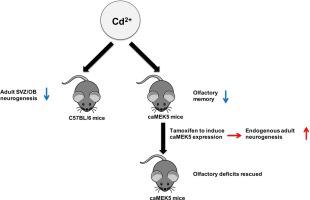NeuroToxicology ( IF 3.4 ) Pub Date : 2020-10-08 , DOI: 10.1016/j.neuro.2020.09.038 Hao Wang 1 , Megumi T Matsushita 1 , Glen M Abel 1 , Daniel R Storm 2 , Zhengui Xia 1

|
Cadmium (Cd) is a heavy metal that is one of the most toxic environmental pollutants throughout the world. We previously reported that Cd exposure impairs olfactory memory in mice. However, the underlying mechanisms for its neurotoxicity for olfactory function are not well understood. Since adult Subventricular zone (SVZ) and Olfactory Bulb (OB) neurogenesis contributes to olfaction, olfactory memory defects caused by Cd may be due to inhibition of neurogenesis. In this study, using bromodeoxyuridine (BrdU) labeling and immunohistochemistry, we found that 0.6 mg/L Cd exposure through drinking water impaired adult SVZ/OB neurogenesis in C57BL/6 mice. To determine if the inhibition of olfactory memory by Cd can be reversed by stimulating adult neurogenesis, we utilized the transgenic caMEK5 mouse strain to conditional stimulate of adult neurogenesis by activating the endogenous ERK5 MAP kinase signaling pathway. This was accomplished by conditionally induced expression of active MEK5 (caMEK5) in adult neural stem/progenitor cells. The caMEK5 mice were exposed to 0.6 mg/L Cd for 38 weeks, and tamoxifen was administered to induce caMEK5 expression and stimulate adult SVZ/OB neurogenesis during Cd exposure. Short-term olfactory memory test and sand-digging based, odor-cued olfactory learning and memory test were conducted after Cd and tamoxifen treatments to examine their effects on olfaction. Here we report that Cd exposure impaired short-term olfactory memory and odor-cued associative learning and memory in mice. Furthermore, the Cd-impaired olfactory memory deficits were rescued by the tamoxifen-induction of caMEK5 expression. This suggests that Cd exposure impairs olfactory function by affecting adult SVZ/OB neurogenesis in mice.
中文翻译:

ERK5 MAP 激酶的诱导性和条件性激活使小鼠免于镉诱导的嗅觉记忆缺陷
镉 (Cd) 是一种重金属,是全世界毒性最强的环境污染物之一。我们之前曾报道过镉暴露会损害小鼠的嗅觉记忆。然而,其对嗅觉功能的神经毒性的潜在机制尚不清楚。由于成人脑室下区 (SVZ) 和嗅球 (OB) 神经发生有助于嗅觉,因此 Cd 引起的嗅觉记忆缺陷可能是由于抑制神经发生。在这项研究中,使用溴脱氧尿苷 (BrdU) 标记和免疫组织化学,我们发现通过饮用水暴露 0.6 mg/L Cd 会损害 C57BL/6 小鼠的成年 SVZ/OB 神经发生。为了确定 Cd 对嗅觉记忆的抑制是否可以通过刺激成体神经发生来逆转,我们利用转基因 caMEK5 小鼠品系通过激活内源性 ERK5 MAP 激酶信号通路来有条件地刺激成体神经发生。这是通过有条件地诱导成年神经干细胞/祖细胞中活性 MEK5 (caMEK5) 的表达来实现的。caMEK5 小鼠暴露于 0.6 mg/L Cd 38 周,并在 Cd 暴露期间施用他莫昔芬以诱导 caMEK5 表达并刺激成年 SVZ/OB 神经发生。在镉和他莫昔芬处理后进行短期嗅觉记忆测试和基于挖沙、气味提示的嗅觉学习和记忆测试,以检查它们对嗅觉的影响。在这里我们报告说,镉暴露损害了小鼠的短期嗅觉记忆和气味提示的联想学习和记忆。此外,他莫昔芬诱导的 caMEK5 表达挽救了 Cd 受损的嗅觉记忆缺陷。这表明镉暴露通过影响小鼠成年 SVZ/OB 神经发生来损害嗅觉功能。











































 京公网安备 11010802027423号
京公网安备 11010802027423号